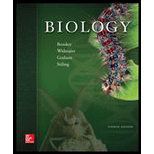
Concept explainers
Introduction: A skeleton is a structure that provides support and protection. It plays an important role in locomotion. Exoskeleton and endoskeleton are the two major types of skeletons found in animals.
Answer to Problem 1TY
Correct answer: A disadvantage of an exoskeleton is that it must be periodically shed. This leave the animal in a vulnerable state. Hence, the correct answer is option b.
Explanation of Solution
Reason for correct answer:
Exoskeletons provide support for the body and protection from the external environment and predators. It plays an important role in the protection of internal organs. They must be periodically shed and replaced in order to allow the growth of the animal. However, the new exoskeleton formed is soft, making the animal more vulnerable to predators and the environment.
Option b. is given as “must be periodically shed, leaving the animal in a vulnerable state”.
The periodic shedding of exoskeleton makes the animal more vulnerable to predators and the environment. This is because, the new exoskeleton formed is soft. Hence, the correct answer is option b.
Reasons for incorrect answer:
Option a. is given as, “cannot protect an animal’s internal organs”.
Exoskeleton plays an important role in the protection of internal organs. It is not a disadvantage of an exoskeleton. Hence, option a. is incorrect.
Option c. is given as, “does not provide any flexibility for the ease of movement of an animal”.
Exoskeletons are tough, durable, and segmented to provide flexibility and to allow movement. Hence, option c. is incorrect.
Option d. is given as, “is a soft, easily damaged structure”.
Exoskeletons are tough and durable. The new exoskeleton formed after molting is soft. Hence, option d. is incorrect.
Option e. is given as, “cannot protect the outside of the body surface”.
Exoskeleton surrounds and protects most of the body surface. It is not a disadvantage of exoskeleton in animals. Hence, option e. is incorrect.
Hence, the options a., c., d., and e. are incorrect.
Thus, a disadvantage of an exoskeleton is that it must be shed periodically. This leave the animal in a vulnerable state.
Want to see more full solutions like this?
Chapter 44 Solutions
Biology
- Outline the negative feedback loop that allows us to maintain a healthy water concentration in our blood. You may use diagram if you wisharrow_forwardGive examples of fat soluble and non-fat soluble hormonesarrow_forwardJust click view full document and register so you can see the whole document. how do i access this. following from the previous question; https://www.bartleby.com/questions-and-answers/hi-hi-with-this-unit-assessment-psy4406-tp4-report-assessment-material-case-stydu-ms-alecia-moore.-o/5e09906a-5101-4297-a8f7-49449b0bb5a7. on Google this image comes up and i have signed/ payed for the service and unable to access the full document. are you able to copy and past to this response. please see the screenshot from google page. unfortunality its not allowing me attch the image can you please show me the mathmetic calculation/ workout for the reult sectionarrow_forward
- Skryf n kortkuns van die Egyptians pyramids vertel ñ story. Maximum 500 woordearrow_forward1.)What cross will result in half homozygous dominant offspring and half heterozygous offspring? 2.) What cross will result in all heterozygous offspring?arrow_forward1.Steroids like testosterone and estrogen are nonpolar and large (~18 carbons). Steroids diffuse through membranes without transporters. Compare and contrast the remaining substances and circle the three substances that can diffuse through a membrane the fastest, without a transporter. Put a square around the other substance that can also diffuse through a membrane (1000x slower but also without a transporter). Molecule Steroid H+ CO₂ Glucose (C6H12O6) H₂O Na+ N₂ Size (Small/Big) Big Nonpolar/Polar/ Nonpolar lonizedarrow_forward
- what are the answer from the bookarrow_forwardwhat is lung cancer why plants removes liquid water intead water vapoursarrow_forward*Example 2: Tracing the path of an autosomal dominant trait Trait: Neurofibromatosis Forms of the trait: The dominant form is neurofibromatosis, caused by the production of an abnormal form of the protein neurofibromin. Affected individuals show spots of abnormal skin pigmentation and non-cancerous tumors that can interfere with the nervous system and cause blindness. Some tumors can convert to a cancerous form. i The recessive form is a normal protein - in other words, no neurofibromatosis.moovi A typical pedigree for a family that carries neurofibromatosis is shown below. Note that carriers are not indicated with half-colored shapes in this chart. Use the letter "N" to indicate the dominant neurofibromatosis allele, and the letter "n" for the normal allele. Nn nn nn 2 nn Nn A 3 N-arrow_forward

 Human Physiology: From Cells to Systems (MindTap ...BiologyISBN:9781285866932Author:Lauralee SherwoodPublisher:Cengage Learning
Human Physiology: From Cells to Systems (MindTap ...BiologyISBN:9781285866932Author:Lauralee SherwoodPublisher:Cengage Learning Biology: The Dynamic Science (MindTap Course List)BiologyISBN:9781305389892Author:Peter J. Russell, Paul E. Hertz, Beverly McMillanPublisher:Cengage Learning
Biology: The Dynamic Science (MindTap Course List)BiologyISBN:9781305389892Author:Peter J. Russell, Paul E. Hertz, Beverly McMillanPublisher:Cengage Learning Medical Terminology for Health Professions, Spira...Health & NutritionISBN:9781305634350Author:Ann Ehrlich, Carol L. Schroeder, Laura Ehrlich, Katrina A. SchroederPublisher:Cengage LearningLifetime Physical Fitness & WellnessHealth & NutritionISBN:9781337677509Author:HOEGERPublisher:Cengage
Medical Terminology for Health Professions, Spira...Health & NutritionISBN:9781305634350Author:Ann Ehrlich, Carol L. Schroeder, Laura Ehrlich, Katrina A. SchroederPublisher:Cengage LearningLifetime Physical Fitness & WellnessHealth & NutritionISBN:9781337677509Author:HOEGERPublisher:Cengage





